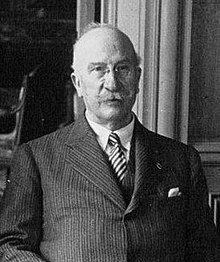Alejandro Lerroux
Alejandro Lerroux García (born March 4, 1864 in La Rambla , Córdoba , † June 25, 1949 in Madrid ) was a centrist Spanish politician who led the Partido Radical during the Second Republic .
Life
As a young man he agitated as the successor to Manuel Ruiz Zorrilla in the ranks of the radical Republicans. As a journalist, he practiced a demagogic and aggressive style in the various publications he directed ( El País , El Progreso , El Intransigente and El Radical ).
His populist and anti-clerical speeches as well as his interventions in various campaigns against the Restoration governments made him quite popular among the workers of Barcelona who later formed the basis of his loyal electorate. In 1901 he was elected for the first time as a member of parliament, again in the candidacies of the Unión Republicana (Republican Union) in 1903 and 1905, which he founded with Nicolás Salmerón . After his transfer to the coalition of Catalan Solidarity in 1906, Lerroux founded his own Radical Republican Party ( Partido Republicano Radical ) in 1908 and led the struggle against growing Catalan nationalism. When the First World War broke out , the majority of Spanish politicians from all parties opted for Spanish neutrality. Only Lerroux and the Liberal Conde de Romanones pleaded for a Spanish entry into the war on the side of the Allies . On various occasions he had to go into exile : for the first time to avoid his conviction according to an article published in 1907, in 1909 he fled from the repression during the tragic week of Barcelona, at the jóvenes bárbaros (Eng. Young barbarians), youth of his party vandalized.
After his return to Spain he accepted the republican-socialist alliance, with which he was re-elected in 1910. When a series of scandals up to corruption allegations burst in which Lerroux was involved, this removed him from his Barcelona electorate until he changed his constituency in 1914 and ran for Córdoba . Under the dictatorship of Miguel Primo de Rivera from 1923 to 1930, his party was weakened in 1929 by the split off of its left wing, which formed into the radical socialists around Marcelino Domingo Barrio . Nevertheless, he continued to take an active part in politics, was involved in the Revolutionary Committee that led to the overthrow of King Alfonso XIII. and prepared the proclamation of the Second Republic in 1931.
During the republic he gained a leading political role. He was part of the republican coalition that supported the reforms of Prime Minister Manuel Azaña from 1931 to 1933, for example in the agricultural sector and in the army. Lerroux joined Azaña's cabinet as Minister in 1931. On November 19, 1933, Lerroux became Prime Minister, mainly because the President did not want to appoint the head of the Catholic-Conservative CEDA , José Maria Gil Robles , as Prime Minister. Lerroux allied himself with the right-wing opposition in October 1934 out of concern about the revolution and thus became part of the conservative majority that took power from 1933 to 1936. From 1933 to 1935 he became Prime Minister three times and took over the War Ministry in 1934 and the Foreign Ministry in 1935 .
The left viewed CEDA's entry into government as a seizure of power by fascism and responded with general strikes , land occupations and the declaration of independence for Catalonia . After Lerroux himself had participated in the suppression of the workers' uprising in Asturias and the independence movement in Catalonia in 1934, he was completely discredited in public opinion by the Estraperlo scandal, his alliance with the political right broke and his position within his own party was himself weakened. The socialist Indalecio Prieto , never at a loss for a biting formulation, commented: "Lerroux and his friends carry away the ministries and the flooring."
In the 1936 elections he was no longer re-elected as a member of parliament, so when the Spanish Civil War broke out, he preferred to move himself out of danger to Portugal . In 1947 he returned to Spain, where he died two years later.
Web links
- Newspaper article about Alejandro Lerroux in the 20th century press kit of the ZBW - Leibniz Information Center for Economics .
| predecessor | Office | successor |
|---|---|---|
| Manuel Azaña |
Prime Minister of Spain 1933 |
Diego Martínez Barrio |
| predecessor | Office | successor |
|---|---|---|
| Diego Martínez Barrio |
Prime Minister of Spain 1933–1934 |
Ricardo Samper |
| predecessor | Office | successor |
|---|---|---|
| Ricardo Samper |
Prime Minister of Spain 1934–1935 |
Joaquín Chapaprieta Torregrosa |
| personal data | |
|---|---|
| SURNAME | Lerroux, Alejandro |
| ALTERNATIVE NAMES | Alejandro Lerroux García |
| BRIEF DESCRIPTION | Spanish politician |
| DATE OF BIRTH | March 4, 1864 |
| PLACE OF BIRTH | La Rambla Cordoba |
| DATE OF DEATH | June 25, 1949 |
| Place of death | Madrid |
